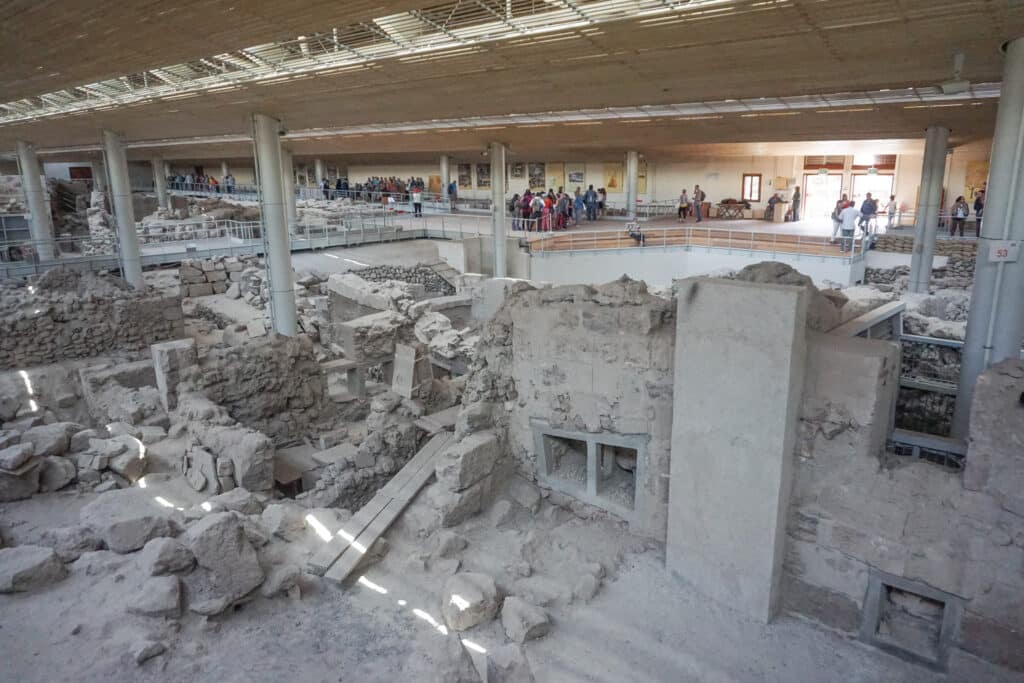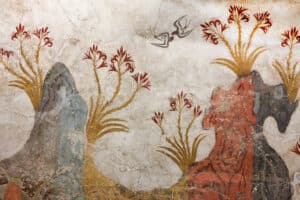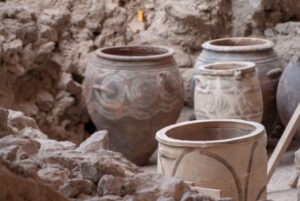
Entrance to the Akrotiri archaeological site is €12 for adults and €6 for people under 25 and EU citizens over 65. The site is open every day from 8 a.m. to 8 p.m. between April 1 and October 31. During the rest of the year, it’s open daily from 8 a.m. to 3 p.m., except for Mondays.
History
Akrotiri is a Bronze Age settlement located in the southwest of the island of Santorini (Thera) in the Greek Cyclades Islands. In the 1.600s BC, one of the largest volcanic eruptions that humanity has ever seen occurred on the Aegean Island of Thera (now Santorini). The volcanic ash preserved the remains of buildings, streets, frescoes, and many artifacts and works of art. The explosion is estimated to equal 50.000 times the atomic bomb dropped on Hiroshima.
In 1866, the first traces of an ancient Minoan settlement were accidentally uncovered during the attempts to extract volcanic soil from Santorini to isolate the Suez Canal Bridge. The excavations in Akrotiri were initiated in the early 1870s by the French School of Archaeology of Athens. The systematic excavations began in 1967 by archaeologist Spyridon Marinatos, supported by the Archaeological Society of Athens.

Springtime Fresco – Akrotiri
Spyridon Marinatos began uncovering the ruins of the ancient city shortly after the excavations began, but his job was not easy. Because the buildings were two or even three floors, the thickness of the ash layer covering the ancient city reached up to 40 meters in certain places, and the structures were heavily damaged by the fires and earthquakes caused by the volcano eruption. Therefore, it was necessary to proceed slowly and carefully.

Akrotiri, Santorini, Greece
Professor Christos Doumas took over the excavations after Spyridon Marinatos passed away in 1974. As a result of the archaeological excavations that have been going on for more than 40 years, an elaborate sewage system, two or three- story buildings covered with walls, incredible wall frescoes, furniture, and household items were found. The items from the Greek mainland, Crete, and other Greek islands, as well as Syria and Egypt were even found inside the buildings.
Since the original name of the discovered city is unknown, the archaeological site took its name from the present-day village of Akrotiri, located on a hill. Akrotiri was a simple fishing and farming village that grew olives and grain in the early days. However, being located on the trade route between Europe and the Middle East, it prospered and became a large, prosperous port city. People lived in two or three-story houses with balconies, underfloor heating, hot and cold-water systems, and some of the first indoor toilets. The Minoans decorated their homes with frescoes and made their own furniture, pots, and sculptures. This situation is surprising when we consider it was during the Bronze Age when people in many parts of the world still lived in huts and built stone flats.
It is even said that Akrotiri was Plato’s inspiration for the city of Atlantis. It is perhaps this level of complexity that has led scholars and historians to believe that Akrotiri was Plato’s inspiration for the city of Atlantis.
In Plato’s Timaios and Kritias dialogues, he speaks of an island with “a great and wonderful empire” that collapsed. “Severe earthquakes and floods occurred; and in one unfortunate day and night, all your warrior men in one body sank to the ground,” Plato wrote, “and the island of Atlantis also disappeared in the depths of the sea.” Some scholars have suggested that Plato’s description of the sudden disappearance of Atlantis is a reference to the explosion of Thera and the subsequent destruction of Akrotiri.
“Akrotiri” is a modern name given to the settlement after the nearby town of the same name. There is no way of knowing what the original inhabitants called this city – perhaps Akrotiri’s real name was “Atlantis”, who knows?
Akrotiri is also often compared with the Roman city of Pompeii, which suffered the same fate in 79 AD and is therefore called “Pompeii in Greek”. However, unlike the Roman Pompeii, no human remains, and precious jewels have been found in Akrotiri. This situation shows us that the residents of the city had enough time to escape. However, we do not know exactly where the people who left ancient Akrotiri went and how long before the explosion they left the island.
Sorry, there were no items that matched your criteria.
